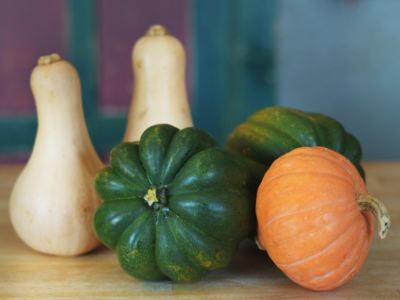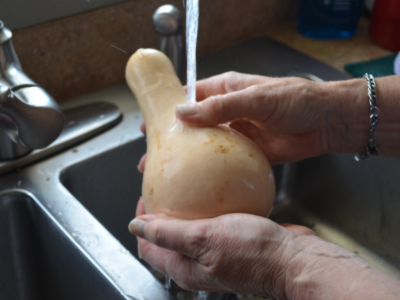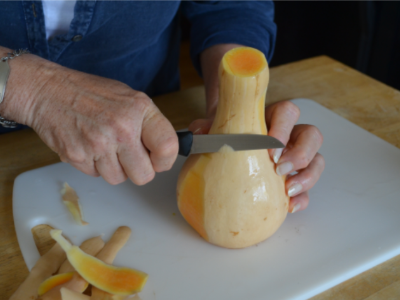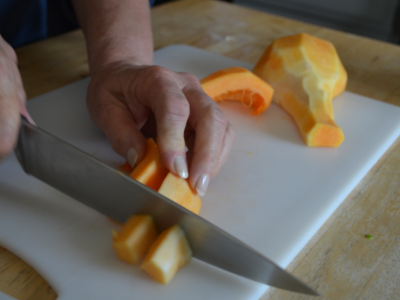Winter Squash

Preparation: Step-by-Step

Wash hands. Thoroughly rinse squash to remove dirt.
Cut end of squash to create a flat edge.
Be sure to hold squash firmly on cutting board.

Place flat side of squash on cutting board and peel.
Use a paring knife or food peeler to remove outer rind.

Cut squash in half. Remove seeds with a spoon. Set
seeds aside to rinse and dry for salads or as a snack. The
halved squash can be roasted or baked. Spaghetti squash
is typically halved and, when tender, spooned out.

Place flat side of halved squash on cutting board and
quarter. To cube, cut evenly to desired size.
Grow.
- Plant winter squash from seeds or starts when soil temperatures have reached
a minimum of 60F (ideally 75‐90F). Varieties include acorn, butternut, carnival,
delicata, hubbard, pumpkin, spaghetti and more. Soil should also be well‐drained and
contain sufficient organic matter to support the nutrient needs of the plant. Squash can
be planted in hills or rows given they have room to trail. Plant seeds ½‐1 inches deep,
about 12 inches apart in rows or 48 inches in hills. Thin seedlings to approximately 24‐36
inches apart in rows or a maximum of three plants per hill.
For more growing information, look for the MSU Extension MontGuide: Planting a Successful Home Vegetable Garden, or contact your local MSU Extension office.
Harvest.
- Winter squash should be harvested at maturity (80‐140 days depending on
variety). Squash should be deep in color. Remove from the vine with a sharp knife or
pruners, leaving the stem on the fruit.
- Select heavy squash with a tough, shiny skin with attached stem. Avoid squash with
signs of
decay, such as cuts, moldy spots, sunken areas or punctures.
- Store in a cool, dry space. The hard skin and attached stem helps retain moisture,
which
extend the storage period ranging between 30 to 180 days, depending on the variety.
- The edible, dark orange winter squash flesh is high in beta carotene which is converted
in the
body to Vitamin A. Winter squash is also high in complex carbohydrates and fiber.
Bake/Roast.
- Peel and cube, or cut squash in half and scoop out seeds. On a foil‐lined baking
dish, place halved squash cut‐side down or evenly arrange cubed squash. Cover and bake
whole squash at 350°F for 45 minutes or until tender. Bake cubed squash at 350°F for 20‐25
minutes.
Boil or Steam.
- Keep whole or cut squash into quarters or cubes and remove the skin and seeds. To
boil squash whole, pierce skin with fork,
cover, and boil for one hour. To steam or boil cubed squash, place pieces into pan of boiling water or steam basket for 10‐15 minutes or until
tender. To mash, use a hand held mixer or masher until desired consistency.
Dry.
- Cut in half and remove seeds and rinse thoroughly to remove strings. Drizzle with
olive oil and low‐sodium seasoning before placing
evenly on a baking sheet. Cook at 300°F for 10‐15 minutes. Stir periodically for even drying.
Microwave.
- Peel and cube squash, or slice squash in half and remove seeds. Place cubes or halves
in a microwave‐safe dish with 2‐3
tablespoons water. Microwave cubes on high for 5‐8 minutes or 8‐12 minutes for halves. To soften thick or hard rinds before cuttng or
peeling, poke holes in rind with fork, and microwave for 2‐5 minutes. Remove from microwave and allow to rest for 1‐2 minutes until cool
enough to handle.
Preserve.
- For more information on preserving vegetables, view these MSU Extension MontGuides: Freezing Vegetables. Or contact your local MSU Extension office.
Puree.
- Roast or bake squash. Puree squash in a blender or food processor to a smooth consistency
and add to soup, breads, muffins or
custards.
Sauté.
- Grate or cube squash. Heat pan to high, add butter or oil to coat bottom of pan and add squash. Sauté 15‐25 minutes, or until tender.
Season.
- To enhance flavor, experiment with low‐sodium seasonings such as allspice, basil, cinnamon, cloves, ginger, marjoram, or nutmeg.
For More Information:
Montana State University Extension: msuextension.org
MSU Extension Master Gardener: mtmastergardener.org
MSU Extension Food and Nutrition: nutrition.msuextension.org
MSU Extension Nutrition Education Programs: buyeatlivebetter.org
Date of Publication: November 2015
